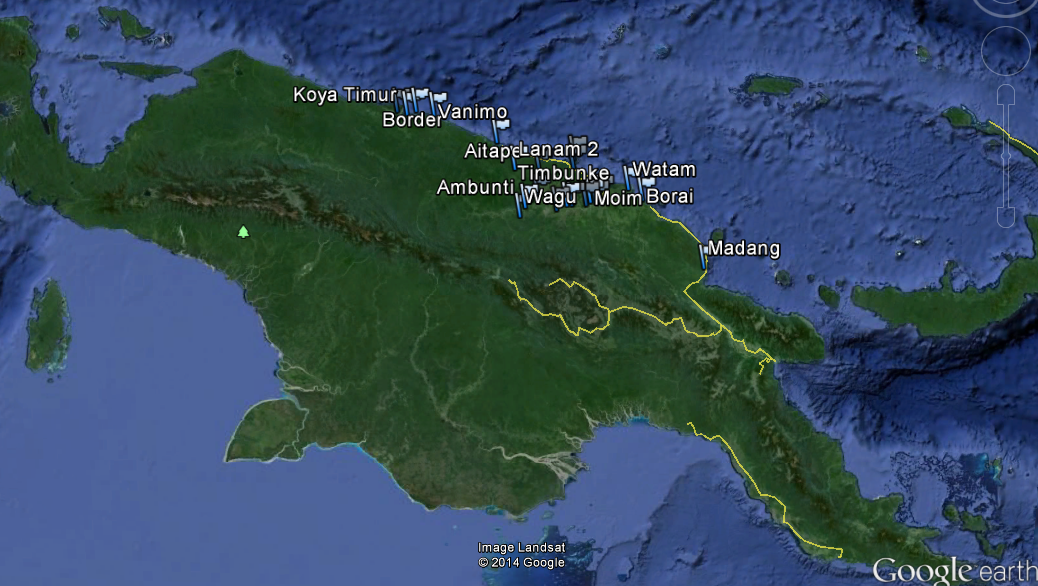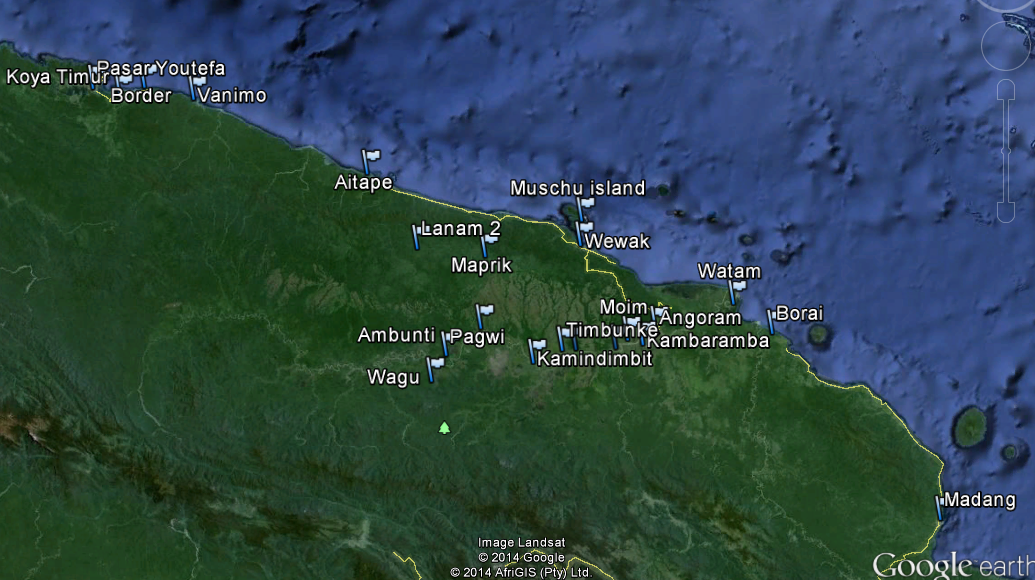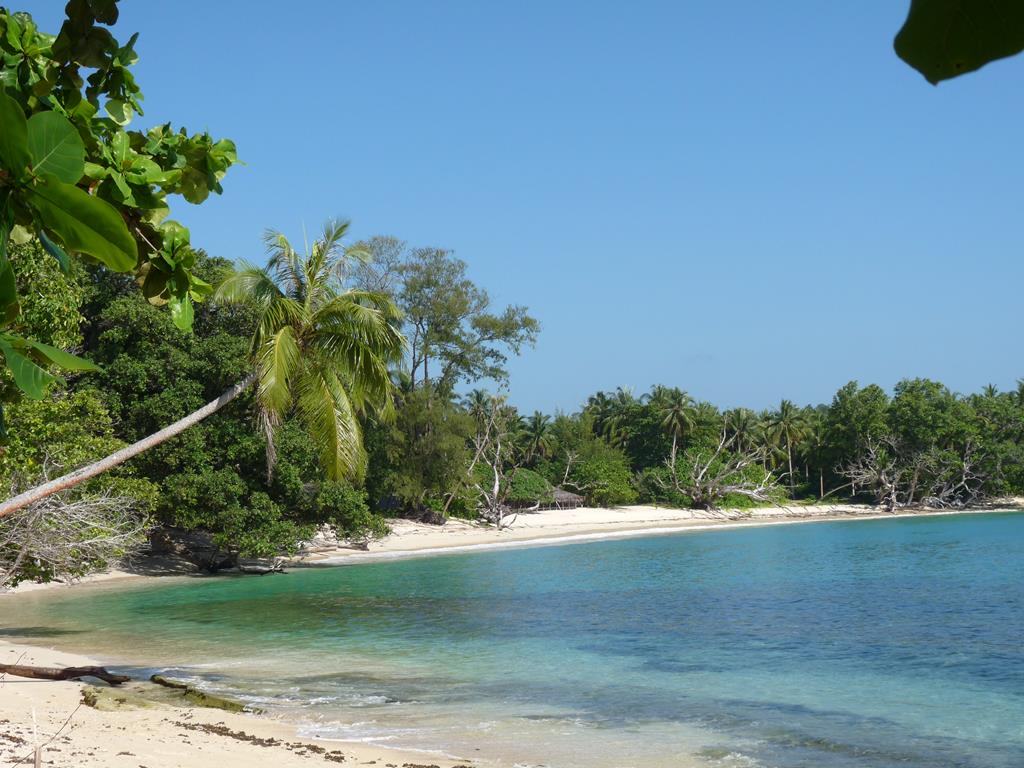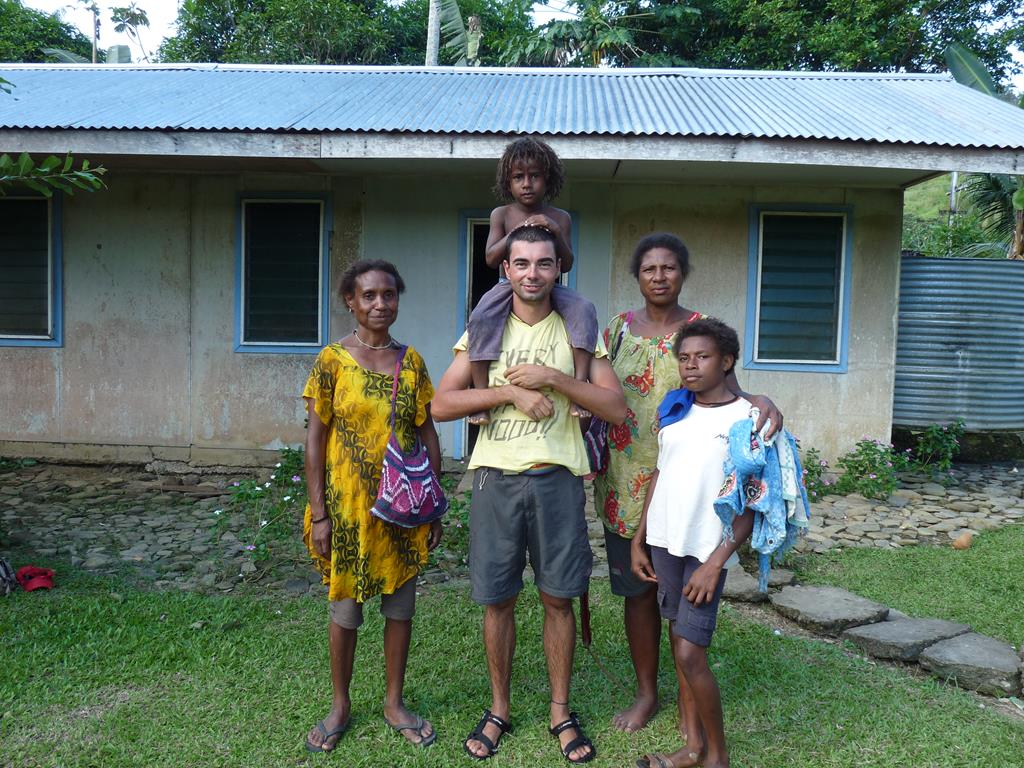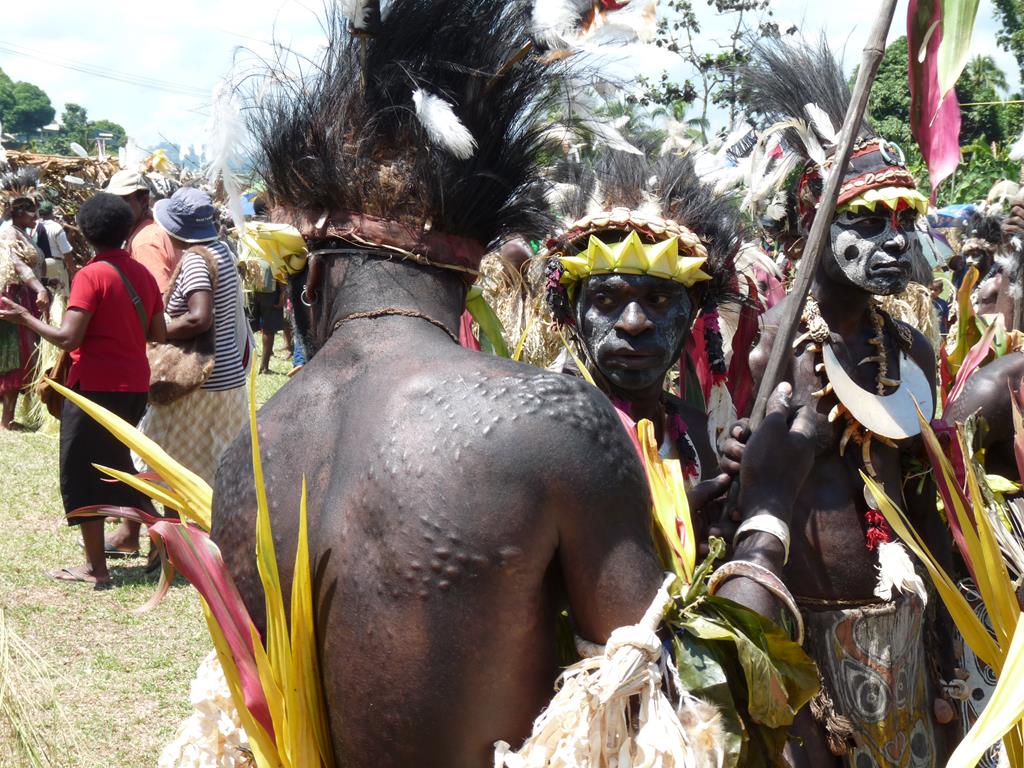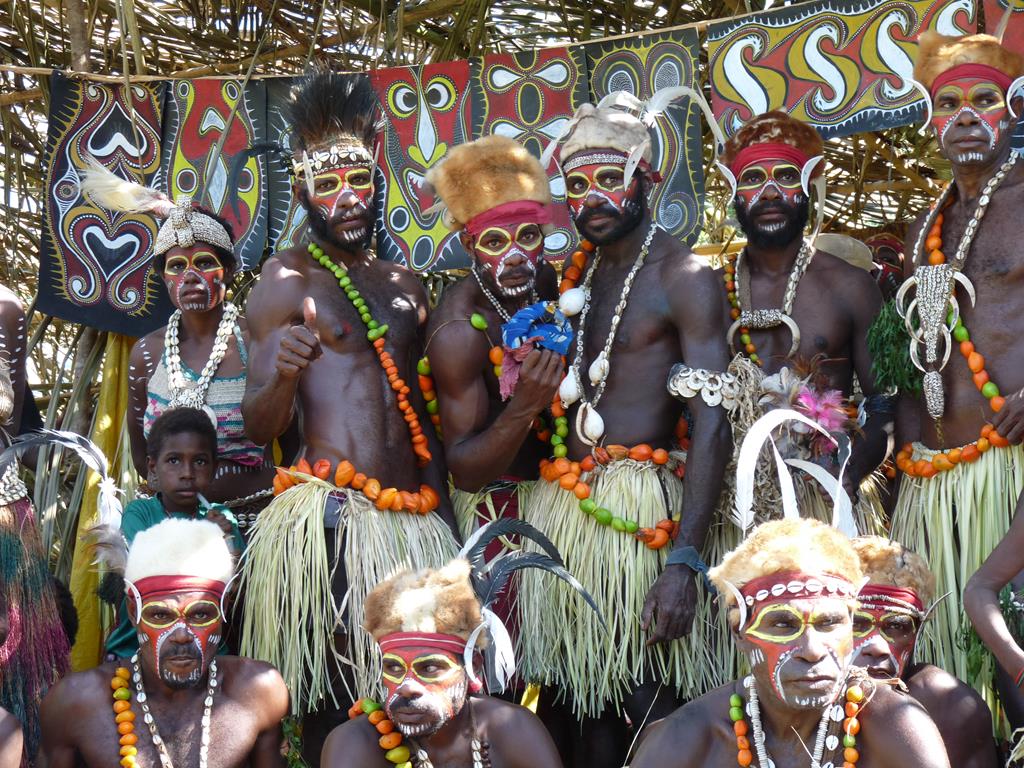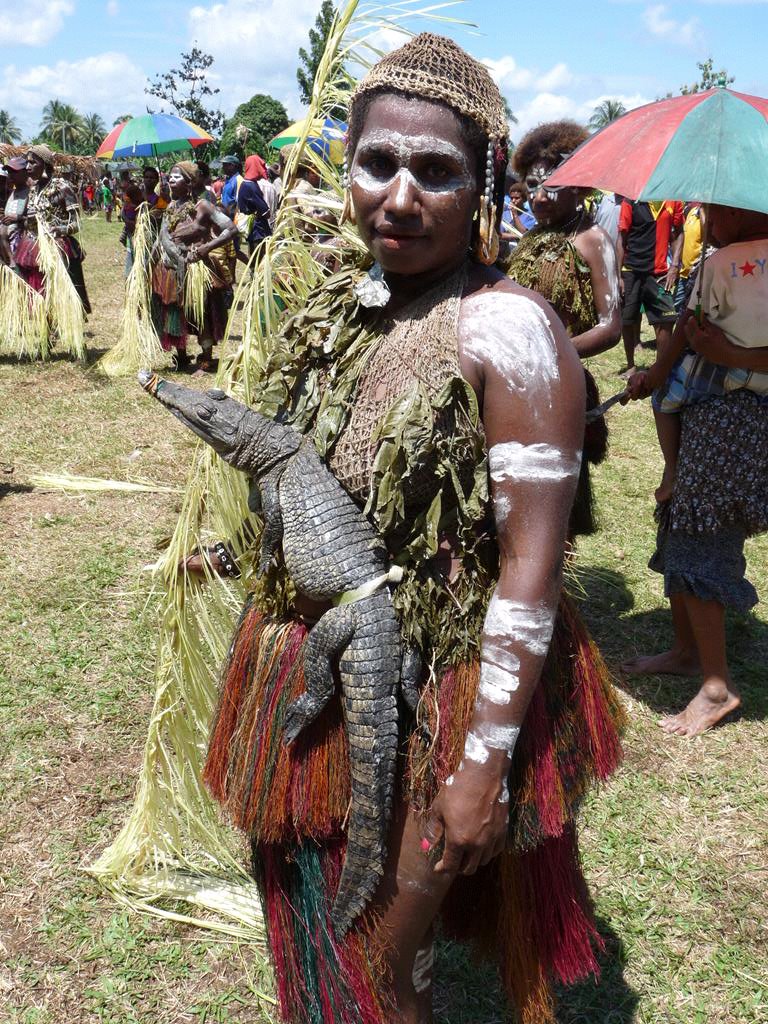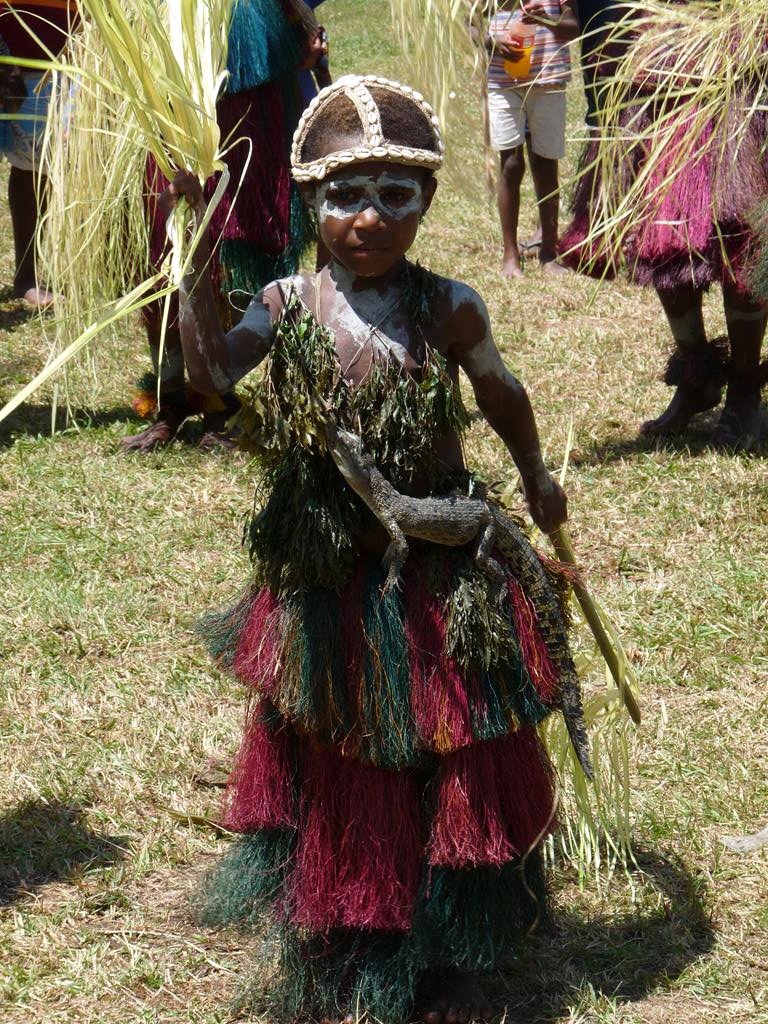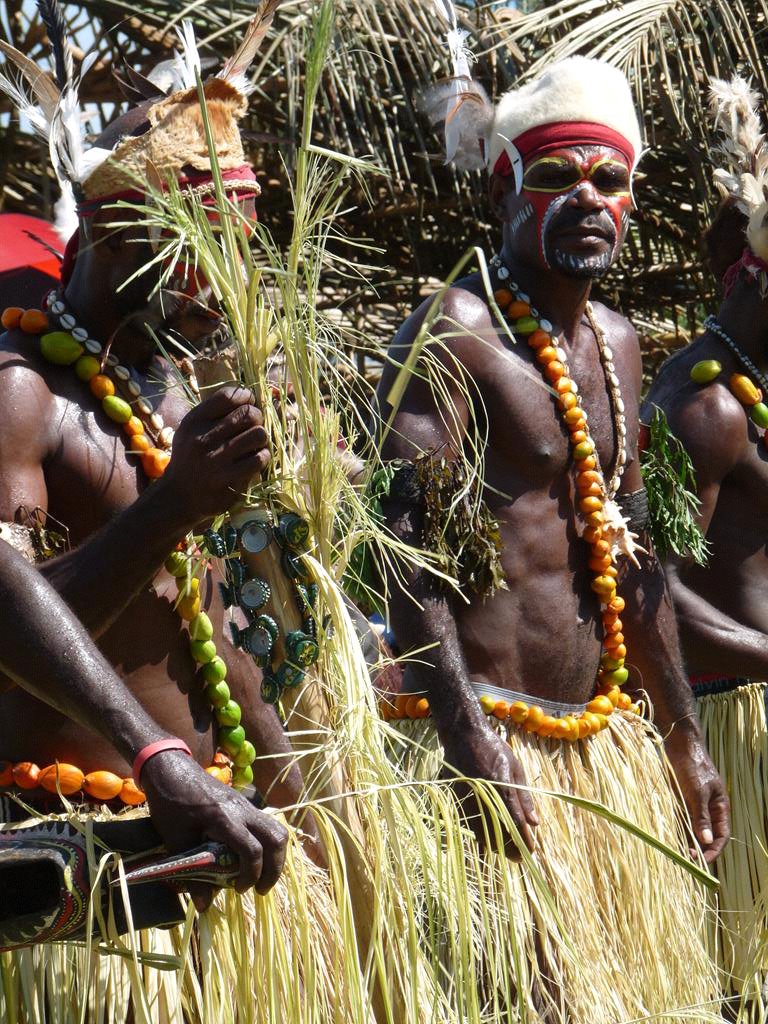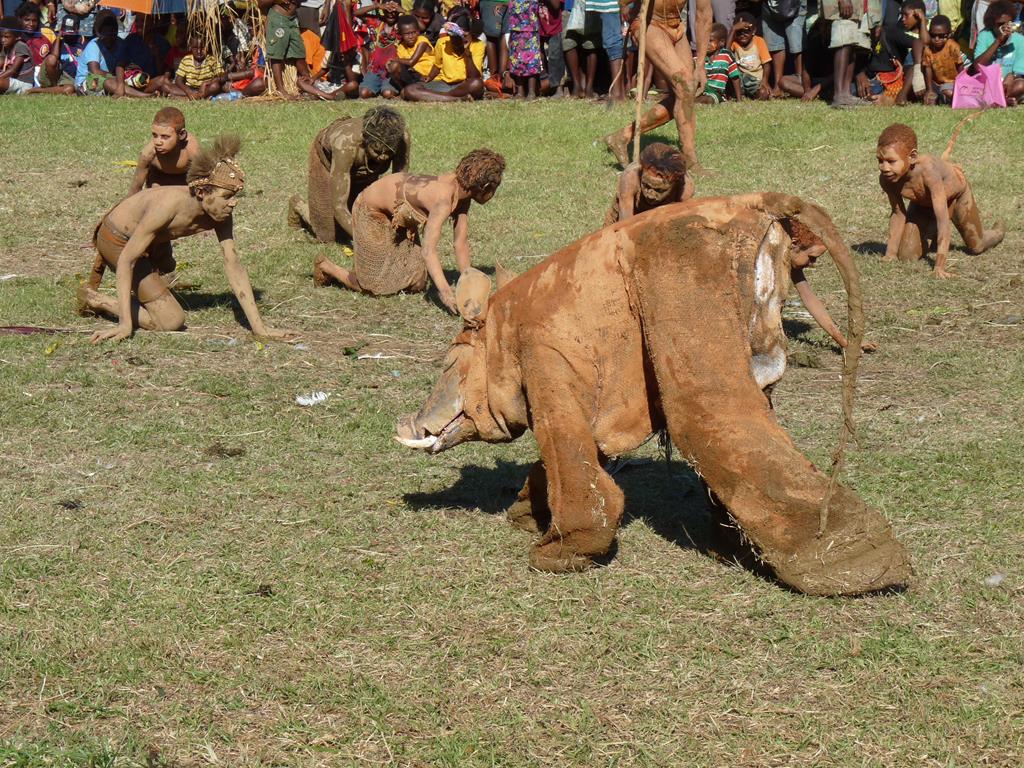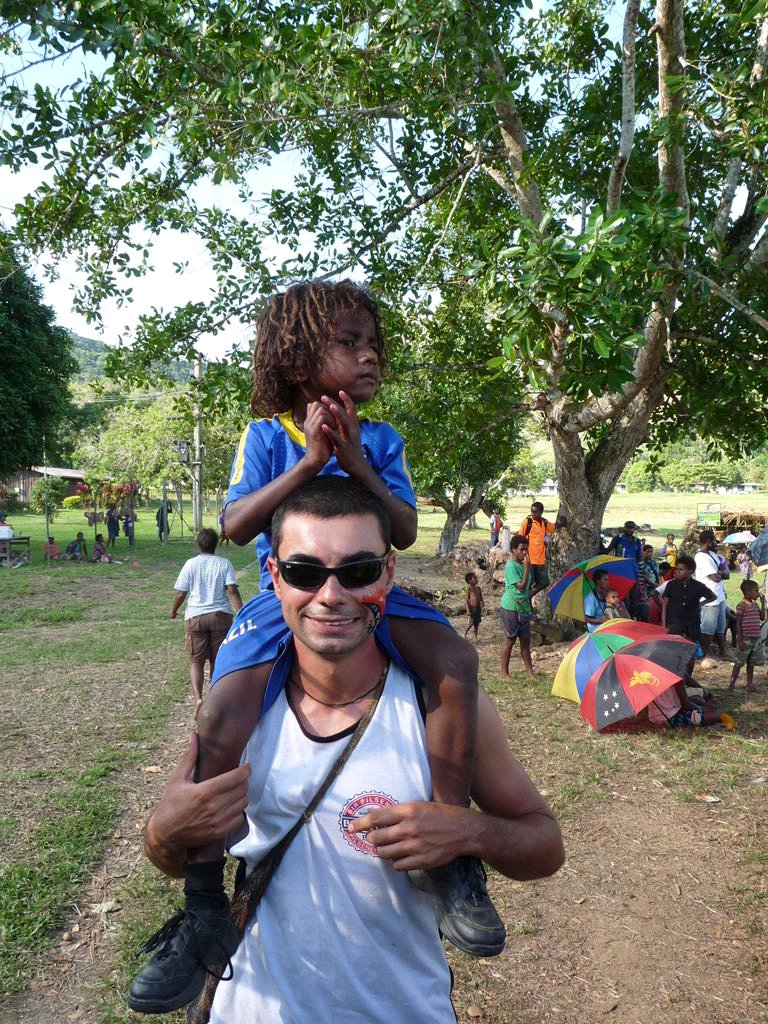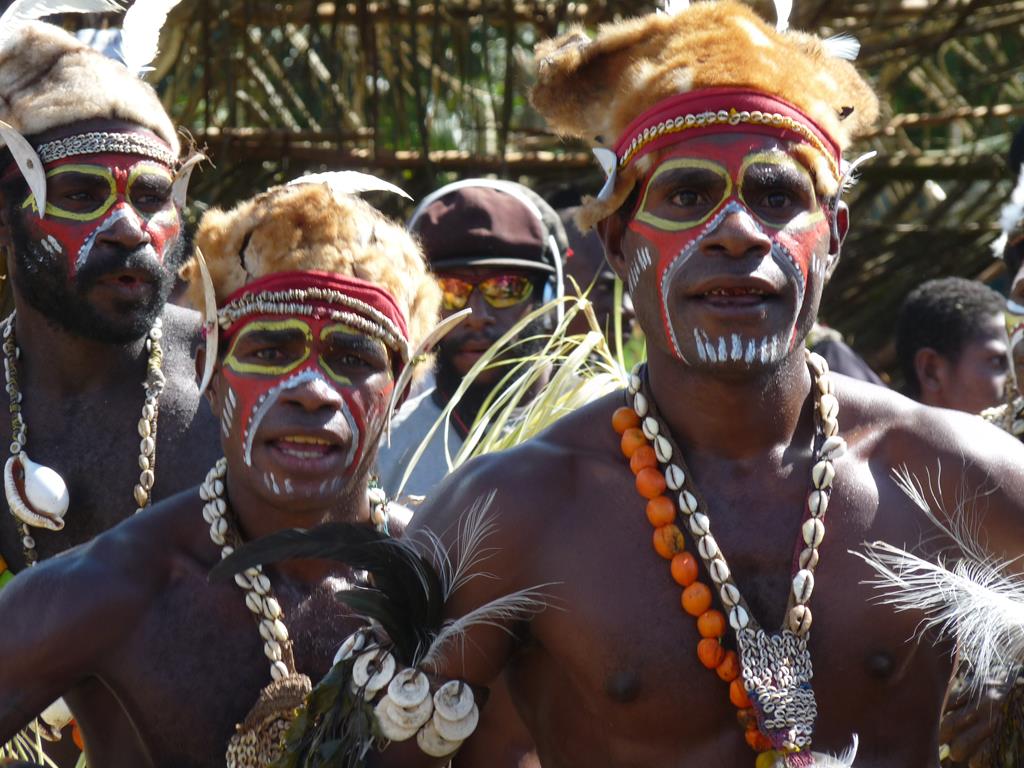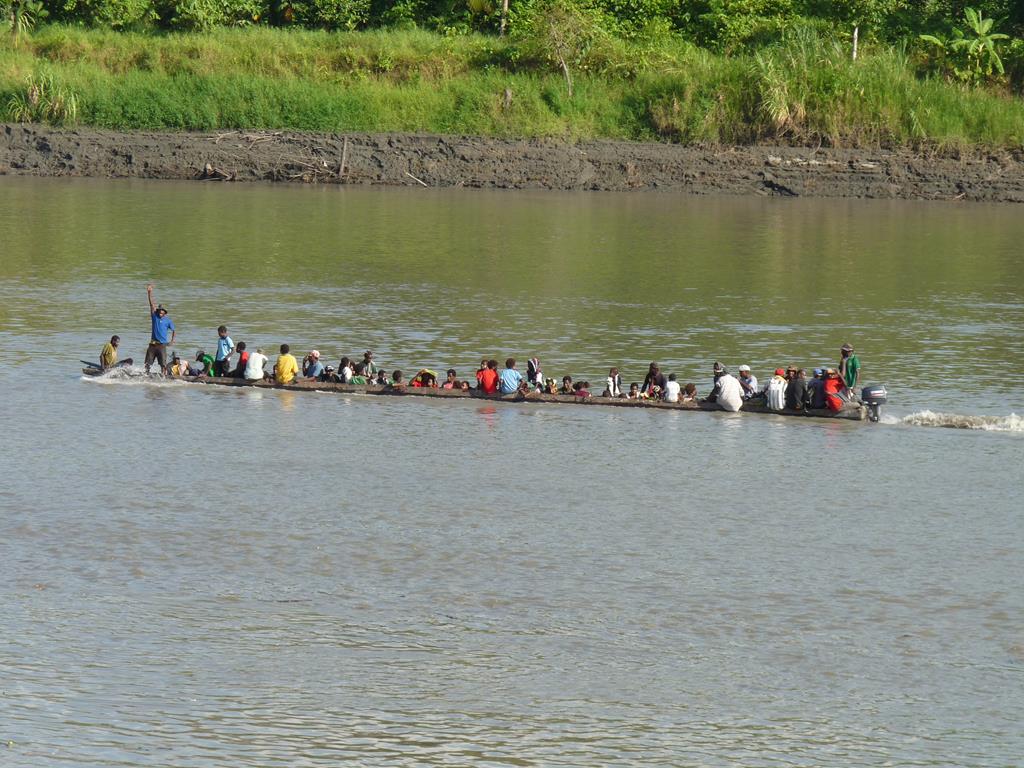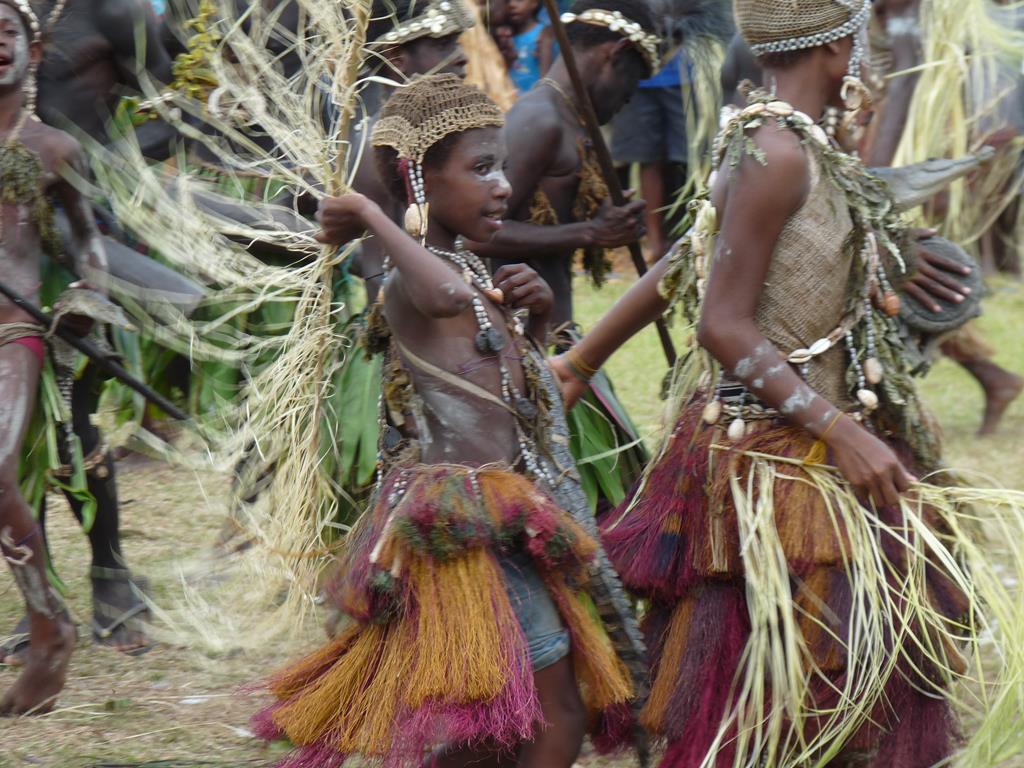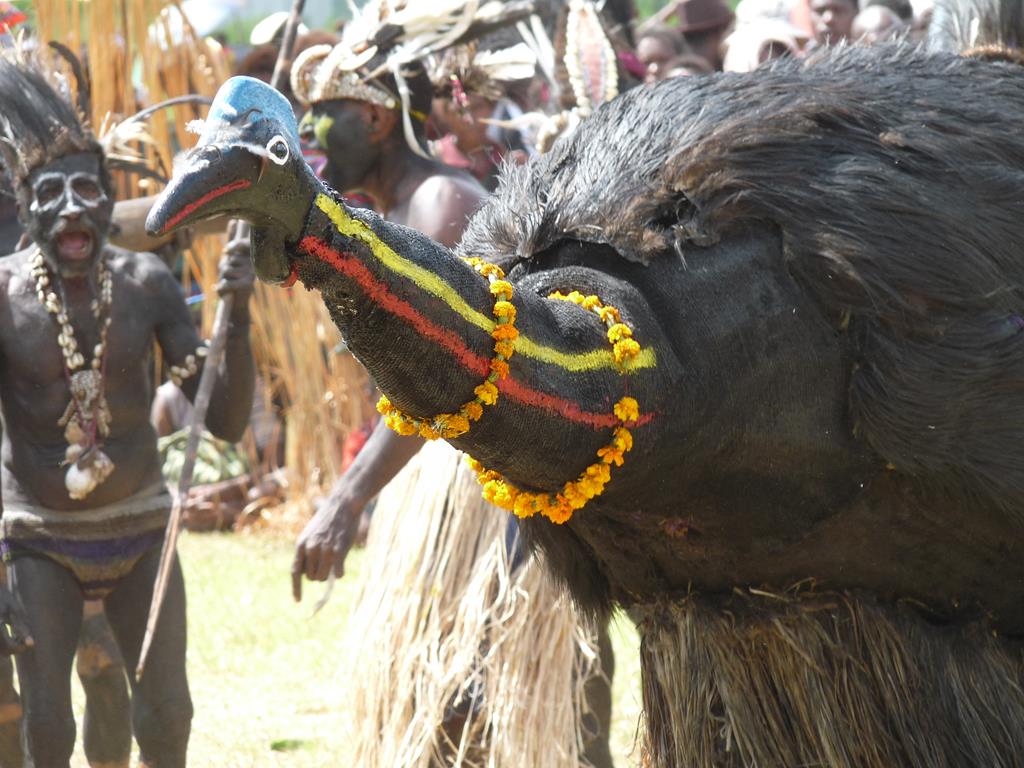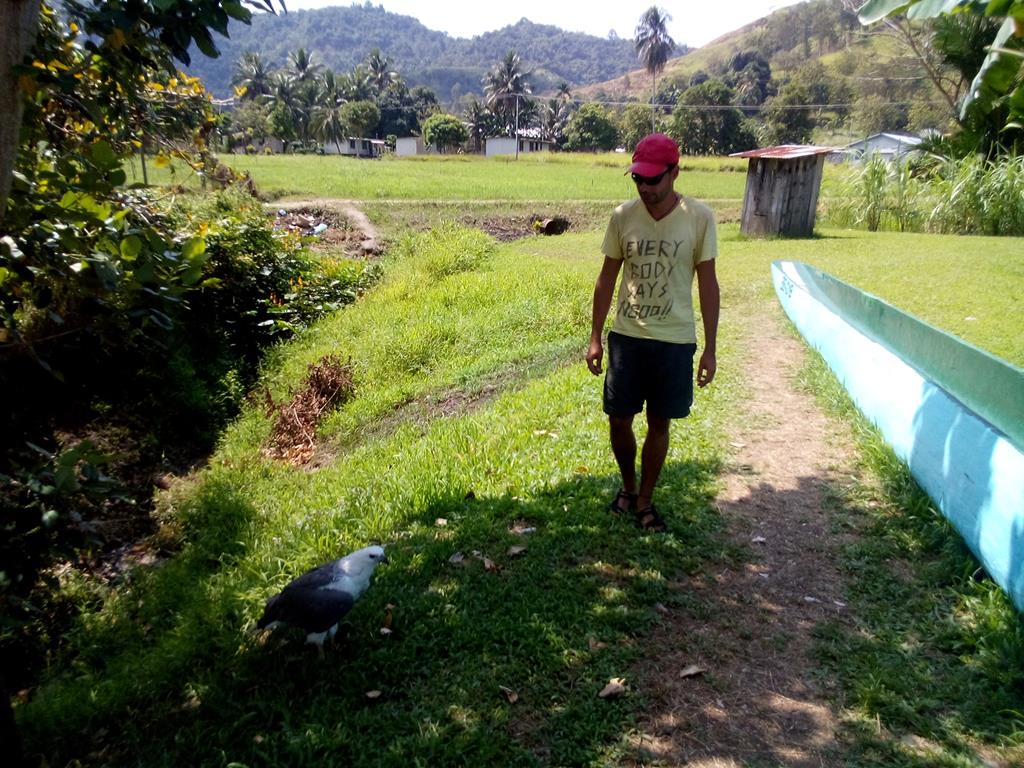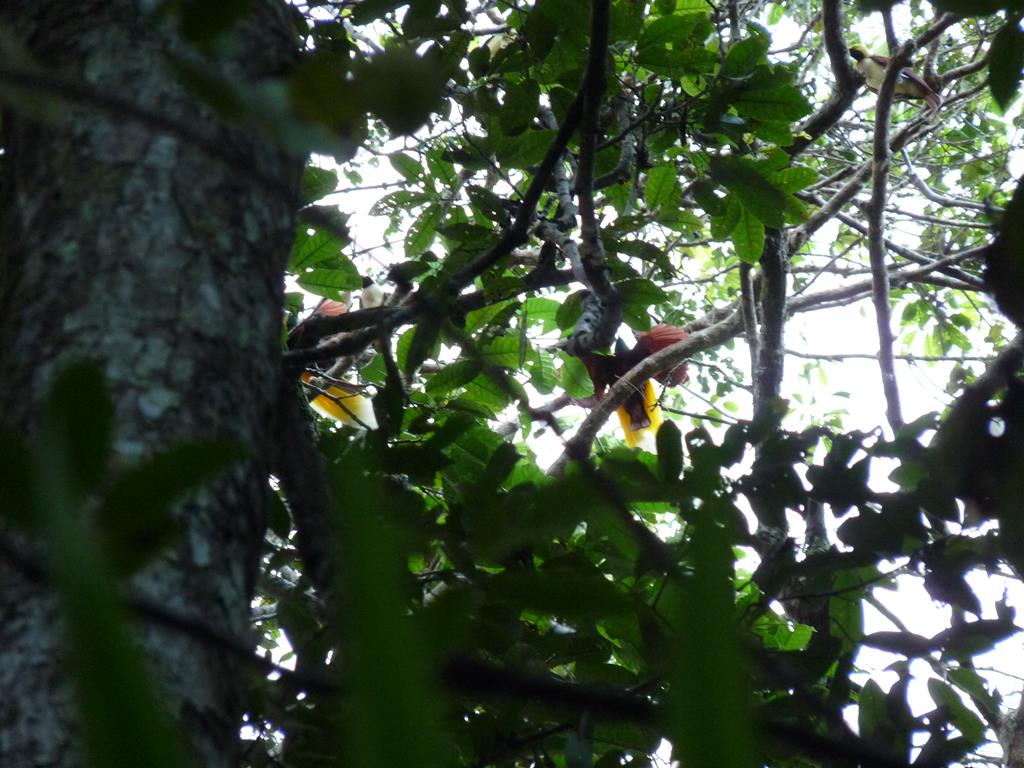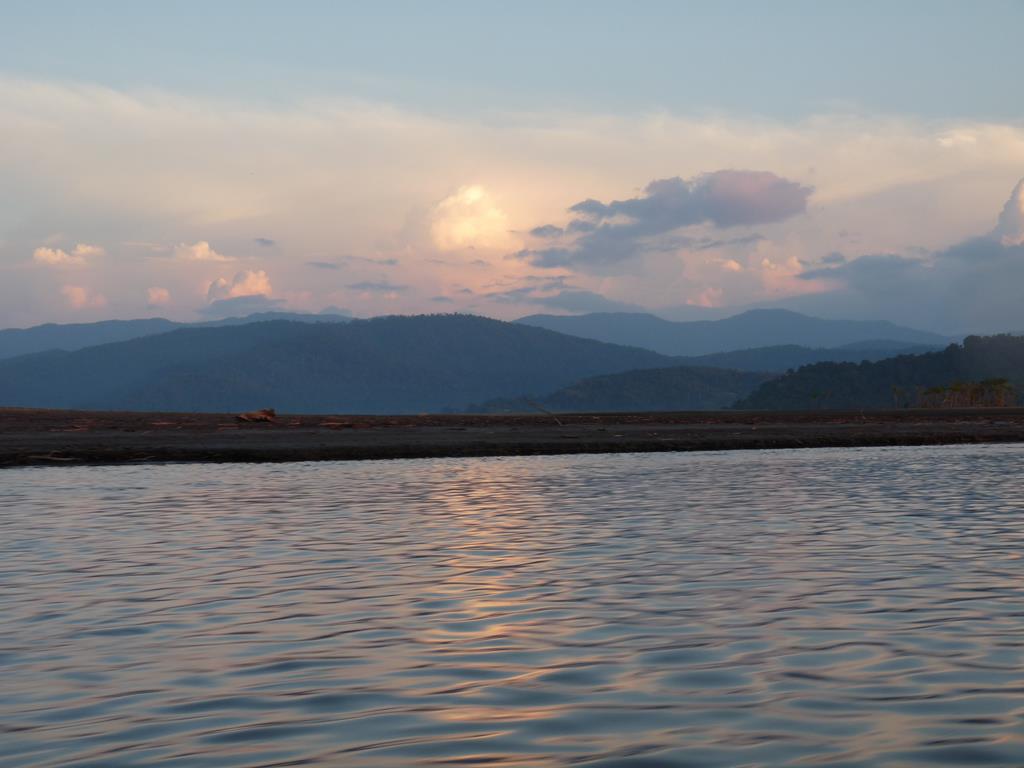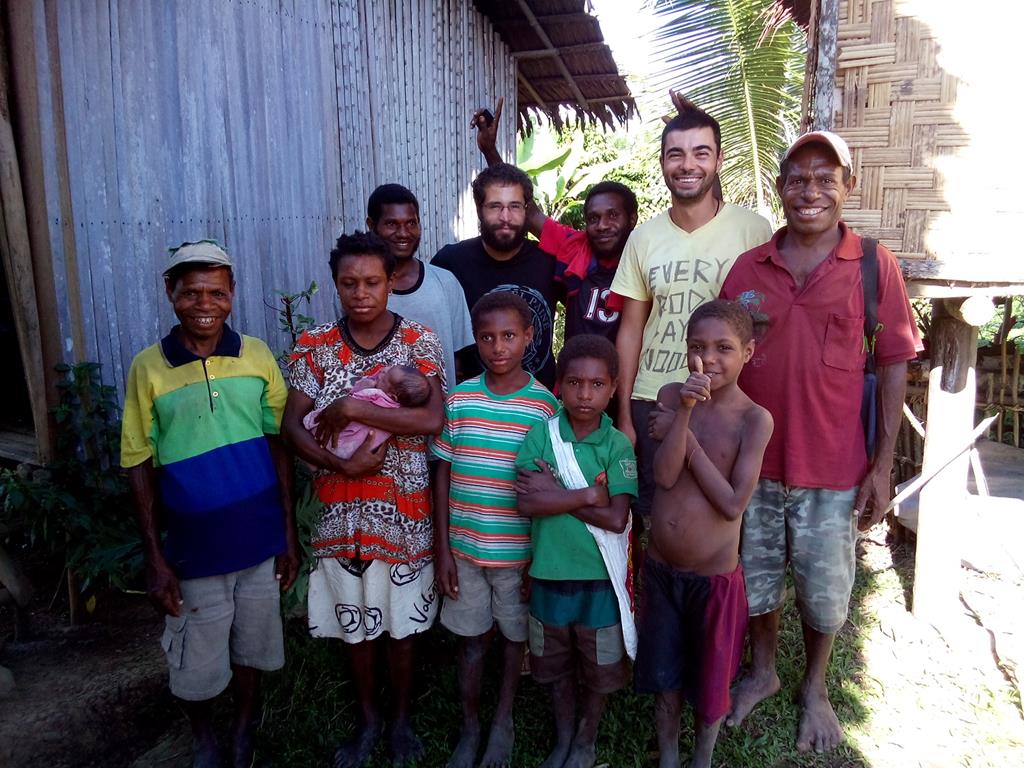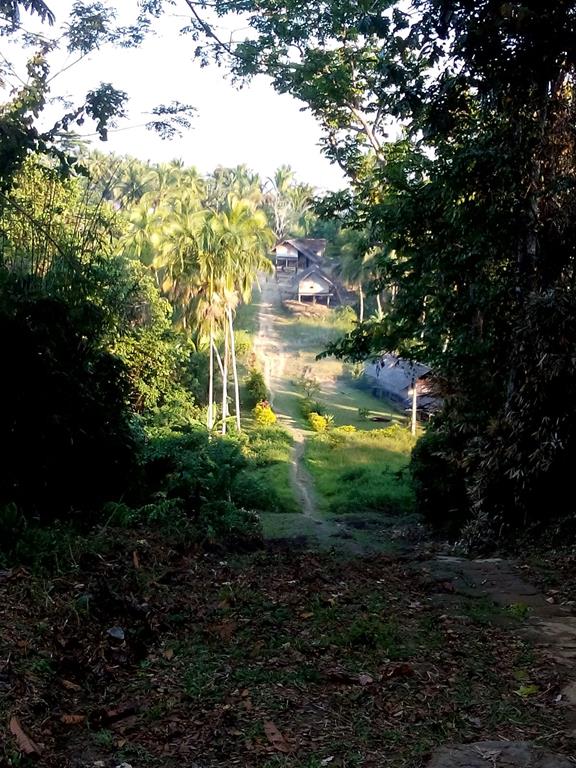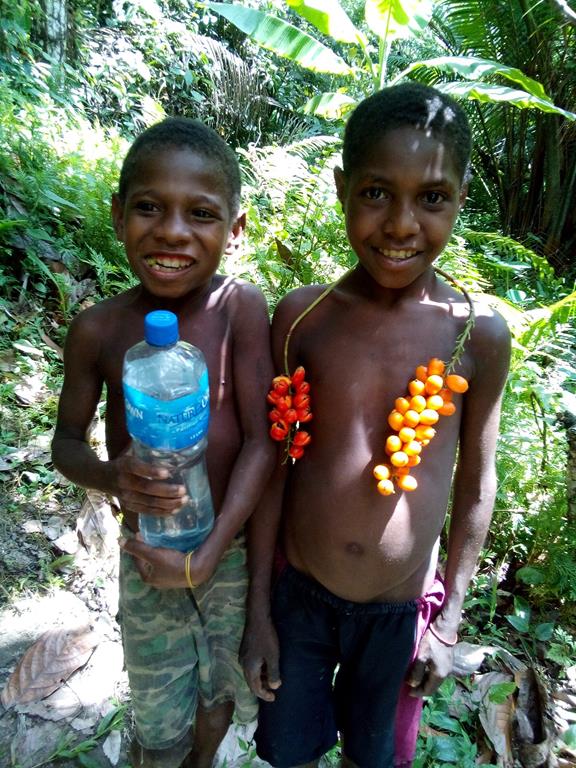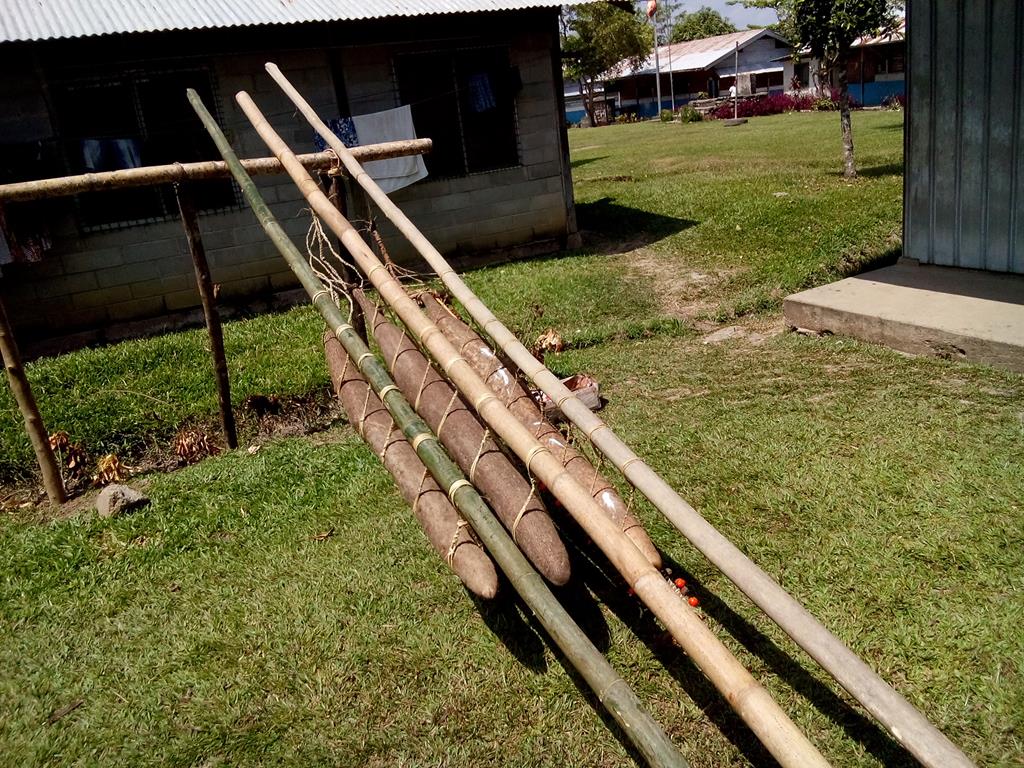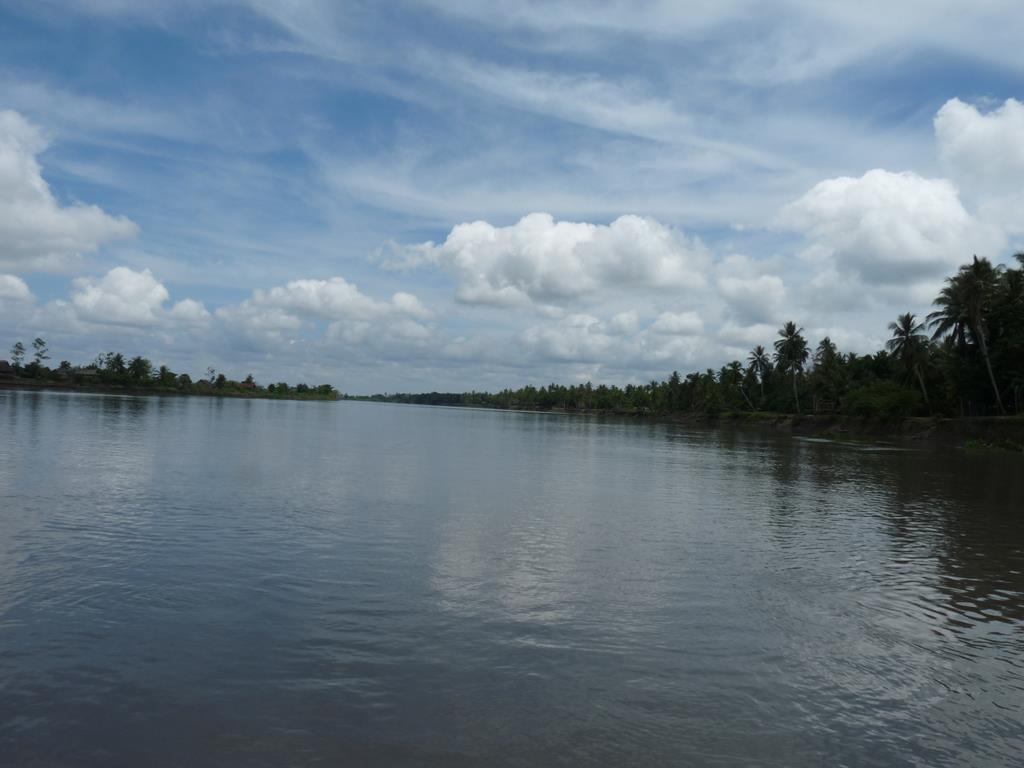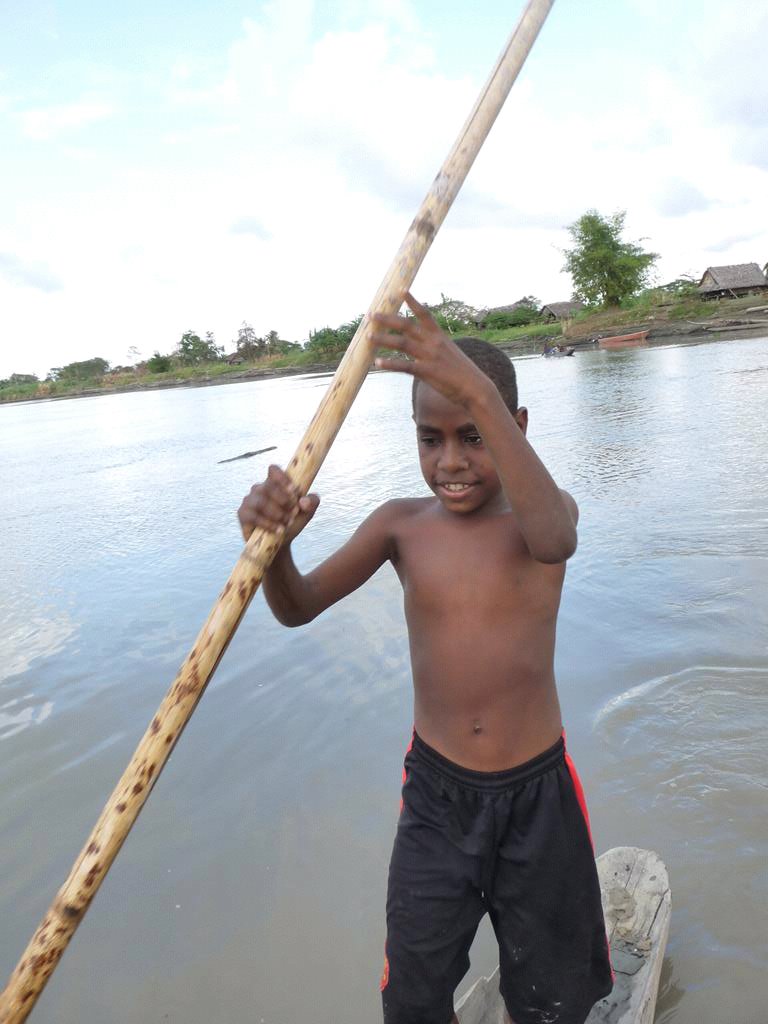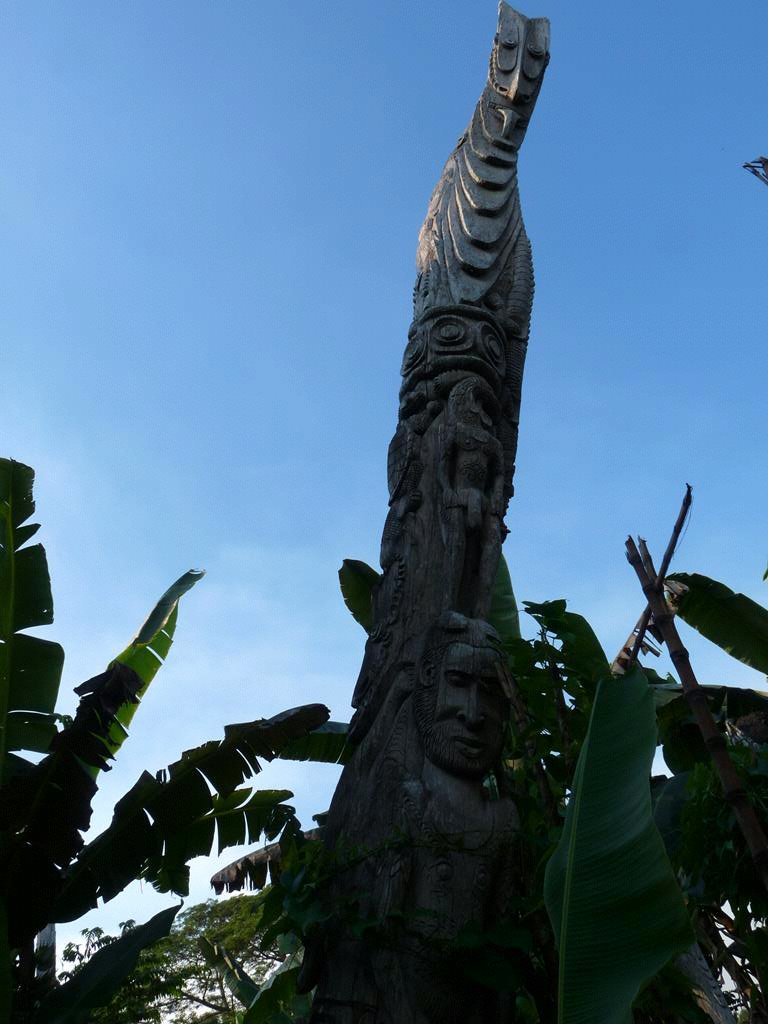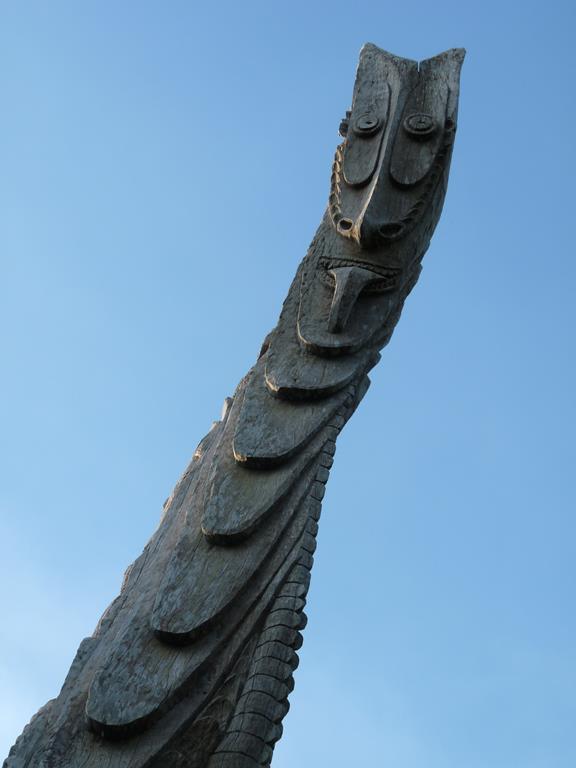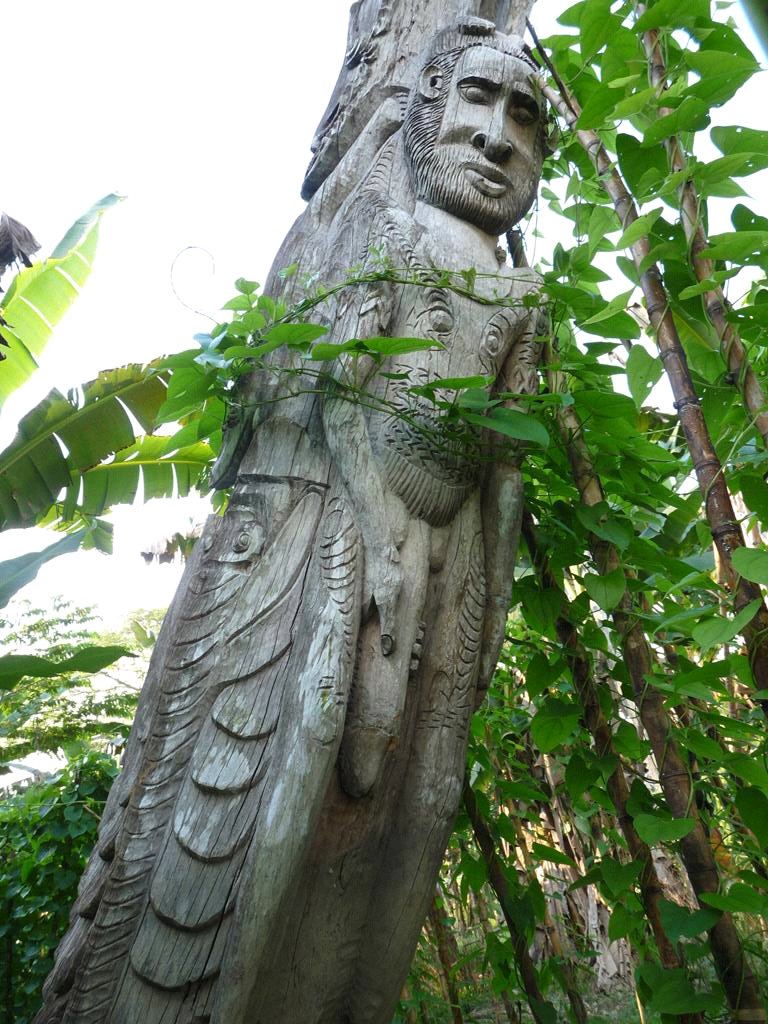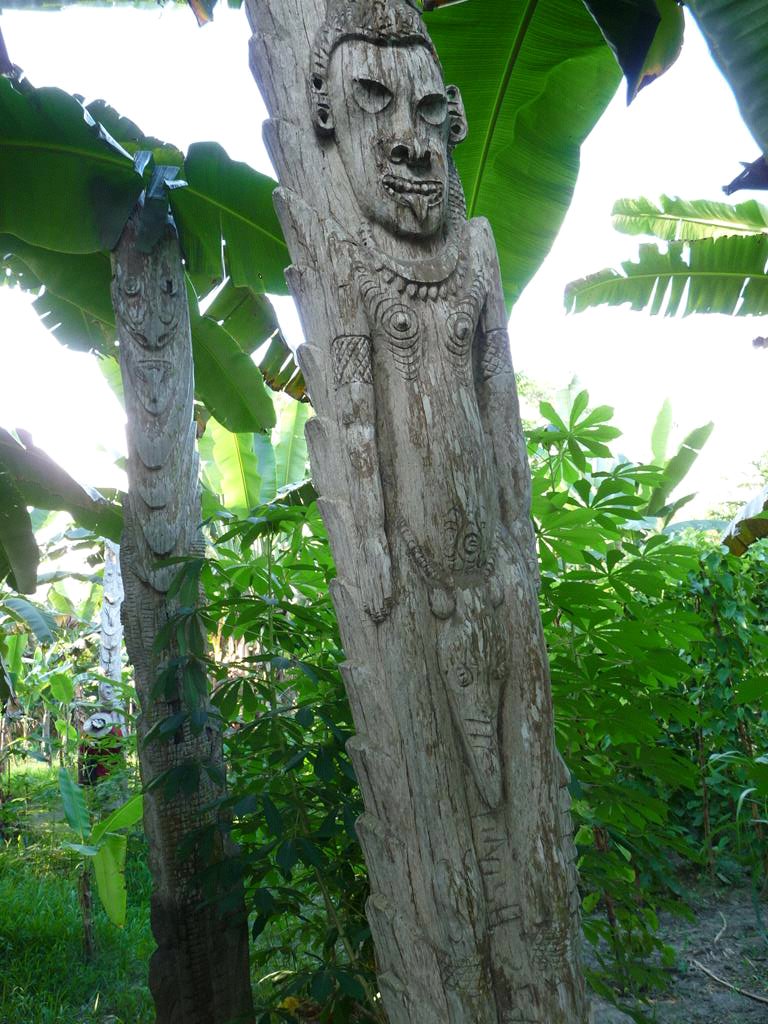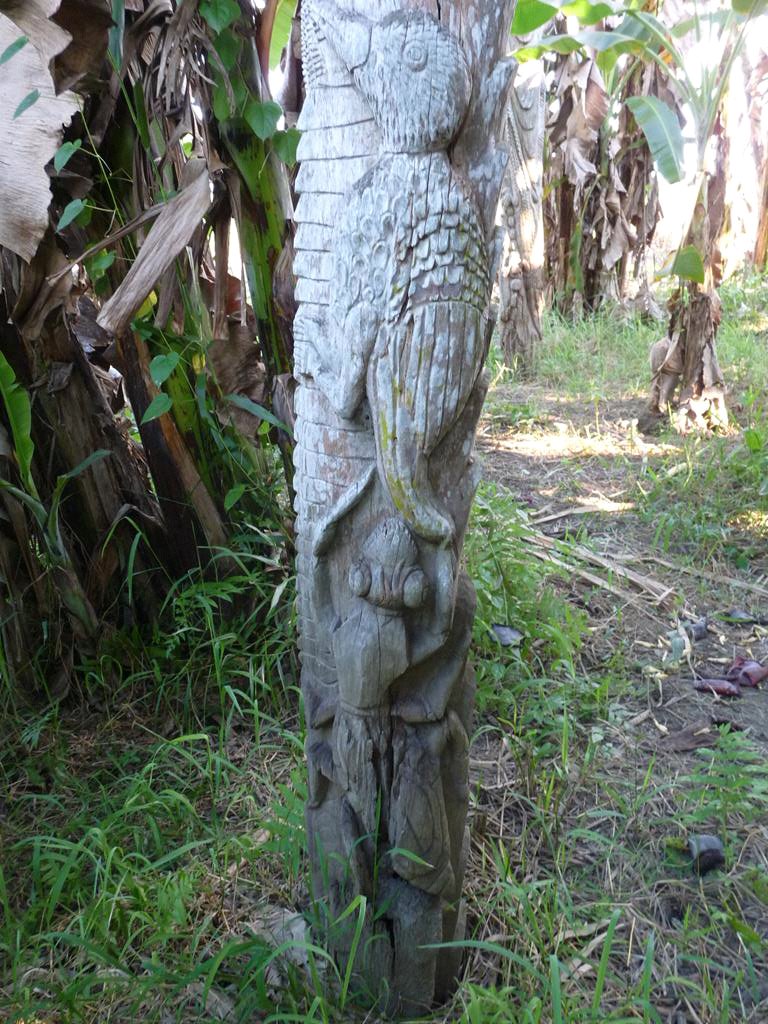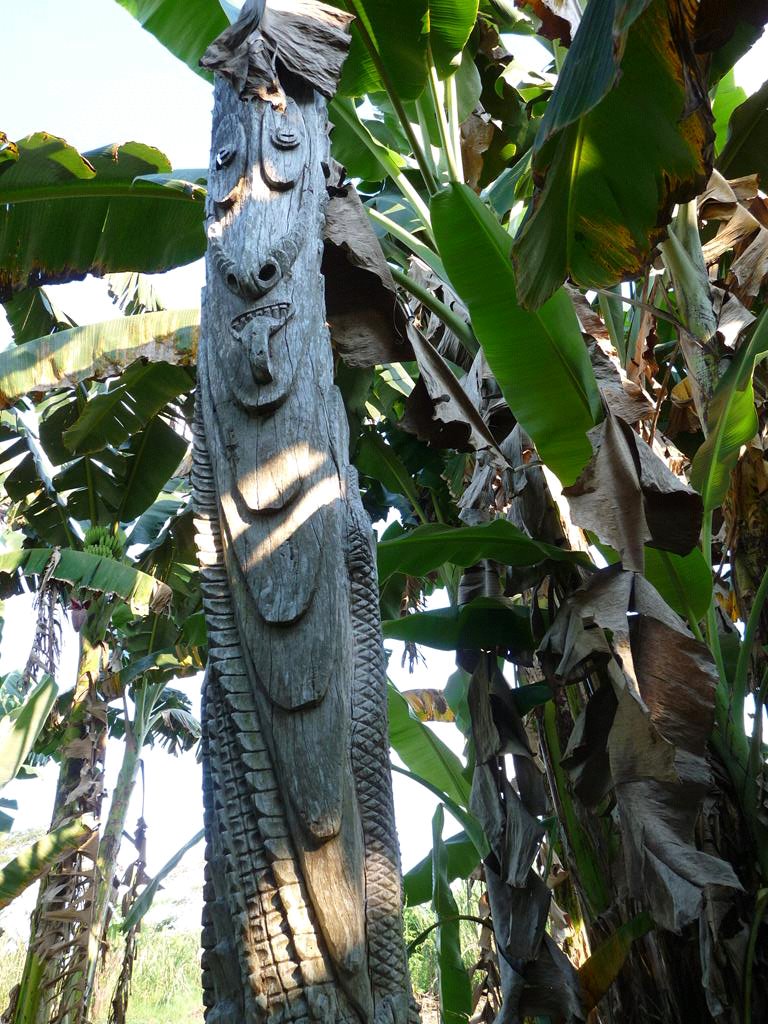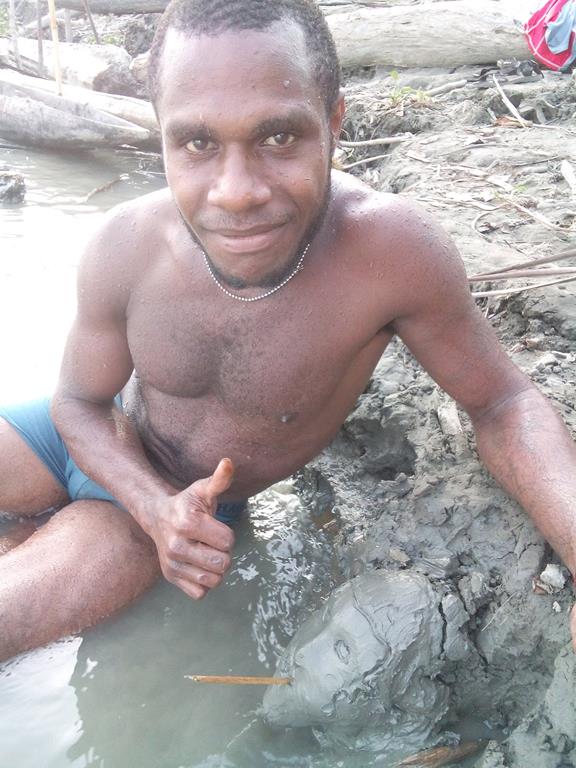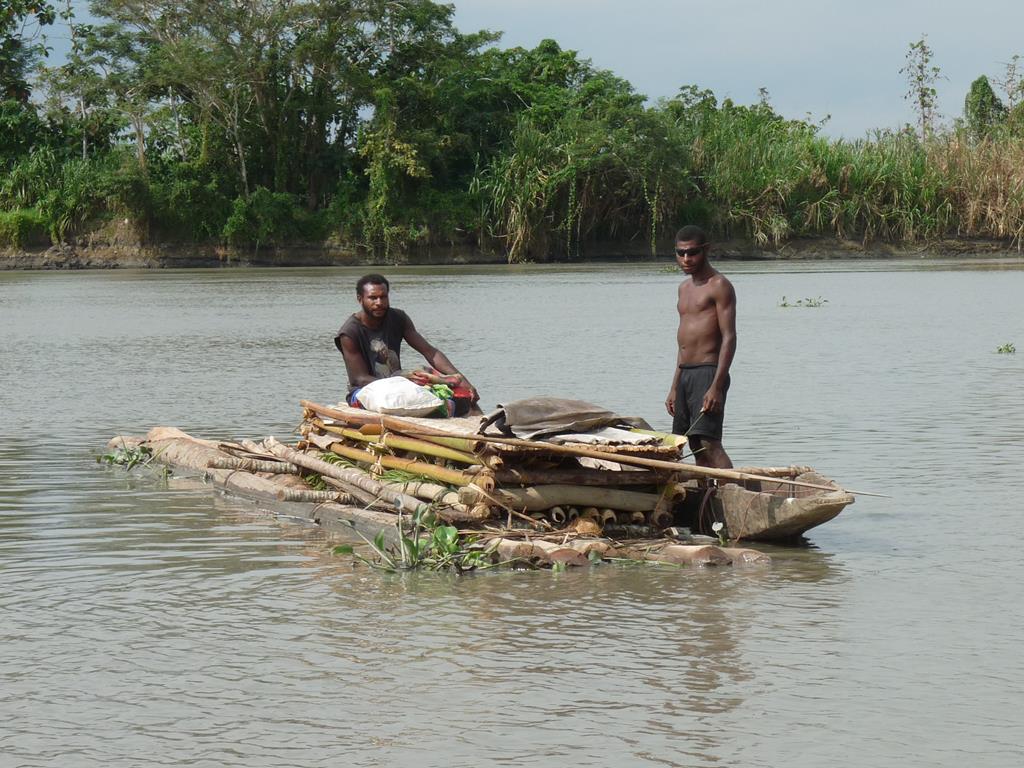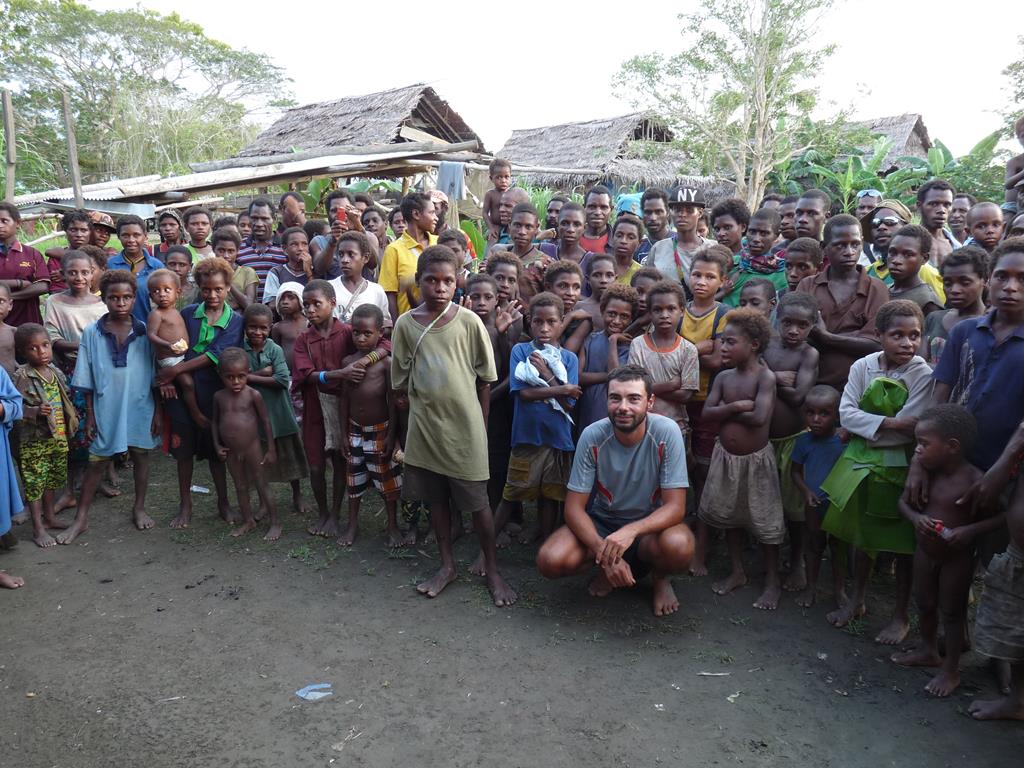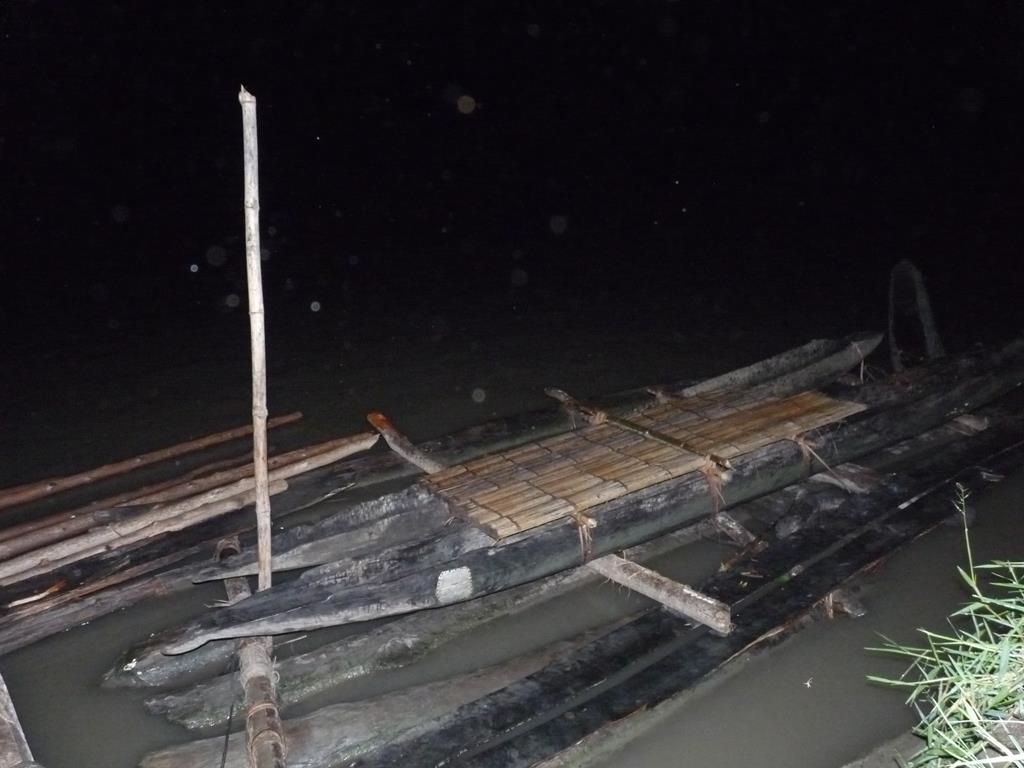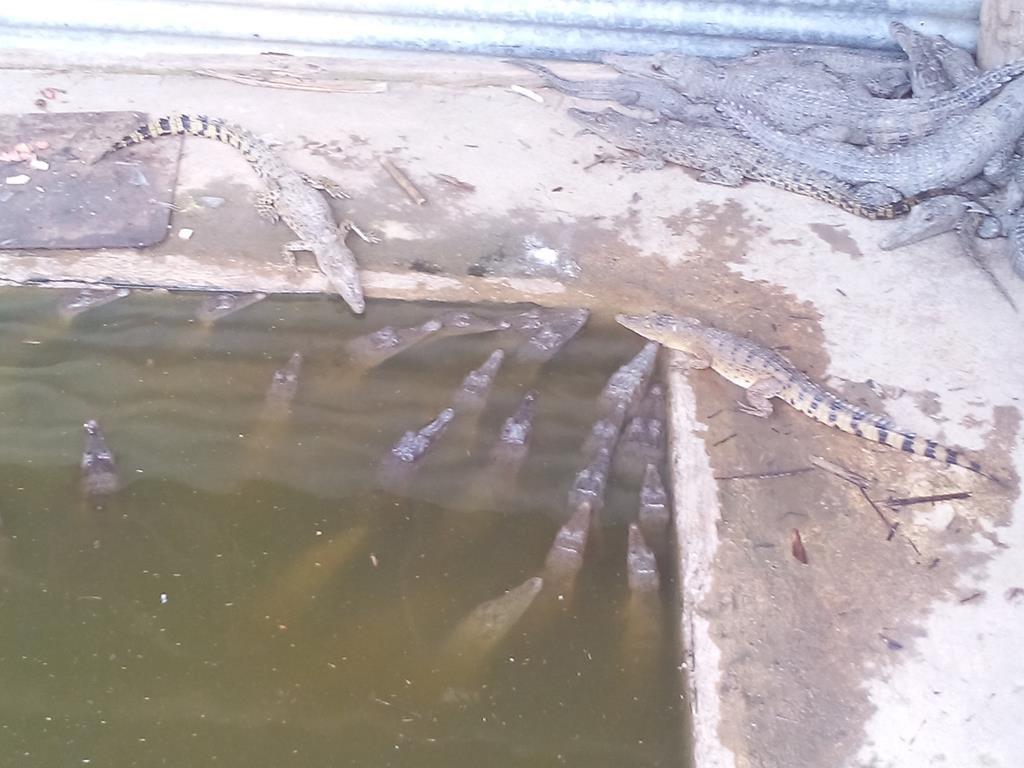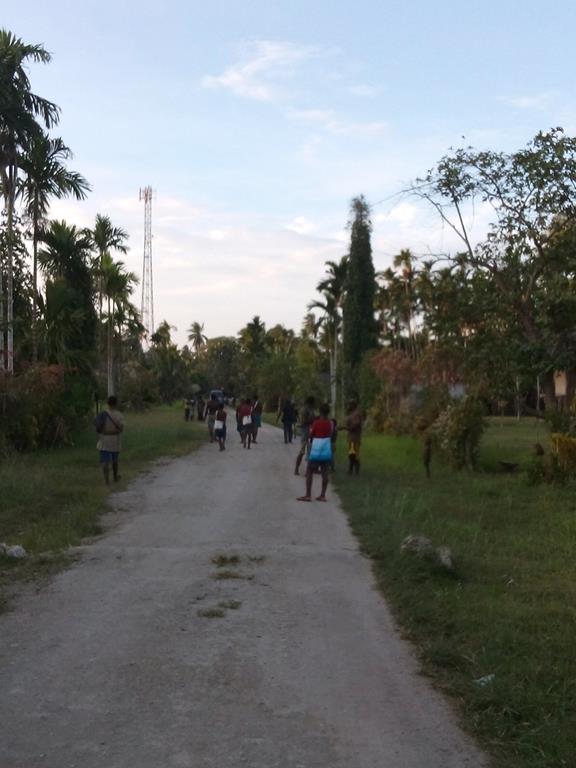Update: I finally got around to putting together a video from the Crocodile festival, almost a year later:) Here it is:
I had wanted to come to Papua New Guinea for years. Its nature and cultures are quite fascinating. It is the most linguistically diverse country in the world with a few dozen language families – around 820 living languages over a population of about 6 million people. Many people here are trilingual. Almost everyone speaks Tok Pisin (Pidgin that is actually a creole), English is the main language of instruction in the schools and then most people will speak their tok ples (local language). People are very proud both of their own cultural heritage and the fact that they belong to the nation of PNG.
Still with Nico, a Canadian couchsurfer I met in Indonesia, we crossed the border from Jayapura to Vanimo one fine Sunday by taking a bus to a village half way to the border and then hitchhiking. We got our passports stamped by the PNG immigration with the wrong date (27 June instead of 27 July) so we had to get it corrected. Luckily Nico was observant enough to notice the mistake. I am planning to stay in PNG all the 60 days that my visa allows so a month is quite a difference.
We were waiting for a bus to come and bring us to Vanimo when an Indonesian man approached us and said he could drive us to town for the same price as the bus. We jumped in. I was curious where he was from because I had heard him talk to someone on the phone and use some Indonesian words I had only heard in East Flores when I went there for Easter. It turned out he was from Adonara, the small island where I spent more than two weeks. He was happy. When we got to town, I gave him my 10 kina for the ride and said “kreu” which was how people greet each other on Adonara. He handed the money back to me and said I didn’t need to pay. After all it pays off to travel to remote Indonesian islands!
This was not a bad start to my travels in PNG. In the coming days I was going to find out that Papua New Guineans are an extremely friendly bunch and super helpful.
Click here for a GPX file to explore in Google Earth.
I have to say that I was not sure what to expect. PNG has a pretty bad reputation mostly due to coverage by Australian media. I first got interested in PNG some ten years back, at the time when George W Bush was killing innocent people in Iraq. Then I read that Port Moresby, the PNG capital, was the second most dangerous city in the world after Bagdad. You also hear stories (urban legends) of “old men being raped in the middle of a city in broad daylight” (?! – I seriously heard that one). Now, after having been here for a month, I can say that most people are extremely friendly and helpful but also very concerned about their own safety and any visitor’s safety. Walking alone in a town or village, someone would normally come to escort me to where I want to go, even if it’s to the toilet. Most potential trouble for visitors is related to raskols – young unemployed men who drink, mostly beer or stim (< steam = home brew). Walking around the streets at night is certainly not a good idea anywhere in PNG but during the day things are quite safe in most places. PNGans are generally quite temperamental people and there is a tradition of warfare and conflict but these tribal wars are usually not related to outsiders. Traffic, volcanoes, crocodiles are other dangers in PNG but more about this later.
Another issue with traveling in PNG is the cost of it. Apart from things that grow in the garden, everything is ridiculously expensive. Cheap hotels start at 80 kina (35 usd). I had a couchsurfing host in Vanimo – Surya from Thailand who works on malaria projects in the bush – educating villagers how to diagnose and treat malaria (sometimes it takes villagers a couple of days to walk to the nearest health center and it might be too late) and distributes medication and mosquito nets (that sometimes end up as fishing nets…) Surya could only host one person so we had to find a cheap place for Nico to stay. We went to the market and asked a friendly lady if they knew a cheap place to stay. “You can stay in my house for free”, she said. Not a bad start! This family also gave us contacts of their friends and relatives in other places where we could stay and be safe. Networking goes a long way in PNG.
For the record :
Ambunti is not a very interesting place in itself but there is mobile phone signal and pretty good 3g. The cell tower is on a hill with nice views over the river.
http://www.youtube.com/watch?v=W7QZnwKqopo
So after Kaminabit we spent a couple of nights in Timbunke after an incident where Nico’s phone got stolen, then we had a short day to Tambanum, then we slept in Krinjambe and in Kambaramba.
PRACTICAL INFORMATION
I have written on the various Wikitravel articles for this area, so that is always a good place to start. The Lonely Planet for PNG is probably good to have, but I found it generally useless for accommodation, transportation and anything that is out of the way of the tour groups.
Border crossing Jayapura – Vanimo: Visas at the PNG consulate in Jayapura are free and take five working days. They will ask for a ticket out of PNG or a ticket out of Indonesia, if you say you will come back to Indonesia overland. There is a market at the border, right on the Indonesian side, a few days a week, where PNGans come to buy cheap stuff. There should be a lot of traffic on such days. Shared taxis from Jayapura apparently ask up to 500,000 IDR for the ride to the border. That is a bit steep. We took a bemo from Pasar Youtefa in Jayapura to the village Koya Timur (only 10,000 IDR), which is half way to the border. There we were offered ojeks for 70,000 IDR to the border, but we hitchhiked instead. From the border there is a bus to Vanimo that charges 10 kina. There is a place to buy kina close to the PNG consulate in Jayapura and it had pretty good rates. When we crossed the border had just been opened after a few months of closure following a shooting. The situation is generally unpredictable. If the border is closed, it should be possible to travel by boat from Jayapura to Vanimo or the other way around, after getting the necessary stamps.
Transportation in PNG is absolutely horrendous. Most people who go longer distances fly. There are countless airstrips and flights go to everywhere. But they are ridiculously expensive most of the time. There is a relatively good road in the highlands and from the Highlands to Madang and Lae, the rest is just stretches of bad road here and there and also ships, boats and canoes for the waterways. Safety is hardly anyone’s priority. Land transport is mostly in PMVs (public motor vehicles) that can range between relatively nice Toyota minivans that ply the Highlands highway and are hardly ever overcrowded because there are police checkpoints for collecting the bribes, to any kind of truck, pickup or whatever with a space in the back where people sit wherever they can. It might be covered or not. Unless it is a short ride between two close places where there are regular vehicles, a trip between any two points will take a whole day (and maybe also the night). PMVs collect passengers around town for hours, driving around and shouting out their destination or hanging out at the market. It is always best to get into one that is full or almost full. Getting into one that is empty means you might leave in 5-6 hours. Or not. You will hear many versions of how long it takes to get to your destination and one of them is: “It depends on the driver”. That is the only truth. Drivers, as anywhere, are not usually the cream of society, and I prefer not to sit in front with them, although many times the white man will be offered that option, as it is more comfortable. The fun is in the back with the other passengers anyway. Two times the driver got drunk while driving. One time he drank six beers within an hour and a half and was puking out of the window (while driving) when we were arriving. Again, on the Highlands highway things are a little bit better but in rural areas it is like that. Another issue with transport is fuel price. Apparently PNG has its own oil but it is refined abroad (probably Australia) and comes back very expensive. Especially on the Sepik river its price more than doubles because it has to be transported there by boats. Boats run on outboarders that consume a lot of fuel. If you want to charter a boat you will probably be quoted a price that excludes the fuel (as a guy said: “The price includes the boat, the skipper and the engine”) and then you will hear a lot of confusing talk about petrol, liters, galons, kilometers, horse powers, engines and what-not and the price quickly rises by the hundreds and thousands of kina.
For this part of the country, there is a road between Vanimo and Aitape that is apparently in horrible condition and people get stuck. If a Land Cruiser goes, they charge 150 kina apparently. Most people travel by banana boat on the sea. It can get quite rough. There are departures every day and we paid 150 kina per person, but some people paid less. It seems to depend on the day and the skipper rather than negotiations. It takes at least 5 hours although they will tell you it is 2.5 hours. There is a company in Aitape called RST (Riverside transport) and their boats are supposed to be the safest and best organized. They are also very friendly people so if you are in Aitape, just go chat to them. From Aitape there is a road in acceptable condition to Wewak and the PMV costs 50 kina. Wewak is the “gateway to the mighty Sepik river”. From Wewak there are roads to Angoram (20 kina by PMV), Pagwi (40 kina by PMV) and Timbunke (20 kina by PMV, seasonal). Apparently there is also a logging road to Kanduanum 2 (downstream from Timbunke) and seasonally PMVs might be going that way. These are the roads to access the Sepik river. From Pagwi it is probably possible to find a PMV boat going upstream to Ambunti almost every day (25 kina) but few boats go downstream. Between Tuesday and Thursday there is a market in Maprik and people from the Sepik go there to sell their smoked fish. We found people from Chambri lakes who had travelled up to Pagwi and Maprik on Tuesday and were going back on Thursday. We found them at the market in Maprik. We paid 45 kina each for the ride from Pagwi to Kaminabit. Between Angoram and Kambaramba there seems to be people travelling every day to do market (10 kina each way). Kambaramba is a nice village to visit. It is pretty big and apparently in the back, in the swamps there are people living in floating houses (they build a raft and the house on top of that and just float on the lake, I think it is tied up to one place most of the time).
The famous buai (betel nut) boats pick up their cargo usually on the Yuat river and then travel downstream, passing Moim and Kambaramba and then stopping in Angoram (eastern bank) to refuel, then travel (at night usually) downstream and through a man-made channel (magical ride) to the village of Watam where a lagoon meets the sea. Here, if the boat is overloaded they will split the cargo and people in two boats and then travel over the sea to Borai, Awas or Bogia, from where there is a road going to Madang. Angoram to Borai/Awas/Bogia (the boats often say they are going to Bogia although they might be going to one of the other villages) is 100 kina. From there there is a PMV to Madang. From Madang it is easy to get to the Highlands or Lae by PMV.
From Wewak there is also a road going to Maprik and further to Nuku that runs parallel to the coast but inland (they call it the Sepik highway). Then from Nuku there is a road down to Aitape so it is easy to make an interesting circle there (they don’t see many tourists here so it is more authentic than on the Sepik river in some ways) in connection with a trip on the Sepik.
From Wewak, banana boats go to the islands around. To Muschu we paid 25 kina one way and the boat seems to bring people to town in the morning and then return around 3 pm (“PNG time”).
There are ships going from Madang to Wewak and Vanimo with Star Shipping (former Rabaul Shipping). Also from Madang to Manus Island (where the Australian government tortures asylum seekers). These are certainly not cheap but have a student price. Just say you are a student. In fact the phrase “I am a student” works wonders all over PNG. It is mostly interpreted as “I am not one of those filthy rich tourists from the tour groups, so don’t expect me to pay 100 kina for what should cost 10 kina”. Just kidding, people are very respectful really!
Also from Vanimo there is a logging road that goes inland to Green River for access to the Sepik river far upstream, close to the Indonesian border. I talked to some people who said Sepiks would take their fish in canoes to Green River, then hire a land cruiser to take their fish to sell it in Vanimo. For an independent traveller it might be possible to hitch a ride on the logging truck probably. I didn’t travel that road so I cannot say. In fact there is another border crossing into Indonesia inland, but that is certainly not open to foreigners and I wouldn’t mess with the Indonesian military. Also this road is understandably frequented by people smuggling guns (think the OPM on the Indonesian side of the border) and marijuana that is grown in PNG. Indonesian laws on drug trafficking are ubiquitous so it might be a good idea to take care who you get involved with on this road. However, if/when I come back, I might try to go to Green river and from there paddle down the Sepik.
As for independent paddling on the Sepik, our canoe cost us 50 kina to buy.
Accommodation in PNG has probably the worst price/quality ratio in the world. Locals travel on business, NGOs and companies pay for the accommodation of their employees and tourists are generally of the rich type and prices are absolutely ridiculous. However, there is a way for the intrepid and adventurous traveler to get around without spending a fortune. A guy from couchsurfing told me he never paid for accommodation during the couple of months he spent in PNG. Well, I am not that good or adventurous, but here are some tips. Number 1: couchsurfing obviously (not very popular but possible here and there). Number 2: Bring a tent! The Lonely Planet once again shat its pants by recommending against bringing a tent out right. I slept in my tent almost every night. And almost every night I had some kind of roof over my head, but the tent certainly protects from mosquitoes(!) (mosquito nets are clumsier and if the locals provide one it will probably be broken, so if not a tent, definitely bring a mosquito net!), cockroaches, spiders, scorpions, rats (your food should stay with you in the tent/mosquito net). Wild camping in PNG is certainly not something that locals have seen and land ownership is taken very seriously (every piece of land is owned by someone) and putting your tent somewhere without permission might get you in trouble (from the landowner or opportunist raskols). If camping, always ask permission and you will probably be offered a place under a roof anyway. 3. Talk to people! PNGans are extremely friendly. If you say you are a student and you want to save money, someone will probably offer to host you. Even if not, making friends goes a long way. Everyone and their mother will give you the phone number of their relatives or wantoks (people from the same tribe) who live in another town so you can call them and stay with them. Most locals will also be delighted to spend time and be seen with a white man. In some remote places there won’t be a guesthouse anyway, so staying with locals is just a matter of asking. When I was hosted somewhere for free, I always shared food. A pack of rice and some tinpis (tuna in a can) will be very much appreciated. They will cook for you and you will share it with the family. Groceries are expensive but things grown locally and sold at the market are cheap. 4. Get a Digicel sim card so you can call your contacts. It was around 15 kina for the card and calls and SMS are bearably expensive. I also bought internet packages and the coverage is pretty good. 5. Ask to stay at churches. Sometimes they operate nice guesthouses that won’t be cheap but other times they will just give you a space on the floor to sleep for free. The EBC (Evangelical Brotherhood Church) had a very basic guesthouse in Wewak for 25 kina a night. They said they also had guesthouses in 18 PNG provinces. Schools might also be an option.
Bargaining in PNG is not a good idea. For some souvenirs on the Sepik they have a second price (and sometimes the price tag lists both and first and the second price 🙂 ). PMVs usually have set prices and it is always best to ask the other passengers how much they are paying. Once a driver told us a higher price than normal but we had no choice so we didn’t argue and at the end he actually asked for the normal price. Now, there is another side of this story: PNG has a reputation of a wild place (both as in “savage” cultures/cannibals etc. and as in a criminal-infested place). Therefore few people make it here and most of them are on organized tours that cost many thousands of dollars. They fly in and out of places on chartered airplanes, have unnecessarily many guides, eat chicken with broccoli (one French lady I talked to was pissed off because she asked to eat some local food – sago, fish, sweet potatoes – but she was told that white men ate chicken and broccoli and not sago), sleep in resorts that cost 800 dollars a night etc. So it is easy to imagine that some locals, who have had contact with such tourists, would think that white people have money to throw around. On the Sepik they have seen tourists, it is on the itinerary of most tours. A Spanish family we met, that was travelling independently, wanted to charter a boat to take them from Pagwi to Angoram. The price started at 6500 kina (2000 euros – the high petrol prices were mentioned a few times and – would you believe – the engine, the boat and the skipper were even included in the price). Normally it is possible to get something like that for a few hundred kina I think. As always, where there are tourists, there are a few dishonest people. When we were paddling down the Sepik, most people were happy to see us, but everyone who had a boat with an engine would right away start a lecture about how dangerous this was and that they could drive us down to Angoram for ONLY this and this much. I would say you should bargain with boat charterers shamelessly. If they are still bargaining, it means they are still interested. However, PNGans are very proud people and certainly don’t like to lose face or feel offended (they are very temperamental and things can quickly get out of control), but a smile, jokes and friendliness are always appreciated. And a lot of patience. The locals say: “expect the unexpected”. Another thing I have experienced (and I have also heard from others) is to be asked for more money after your trip/hike/ride is over. You agree very very clearly on something beforehand, you have a great and friendly time and once everything is over, the driver/guide/skipper asks you for more money, sometimes with the funniest excuses ever. It might be difficult to argue (cultural differences, wanting to keep the friendly connection), but it is best to be firm (don’t forget to smile) and, if possible, show your wallet saying that the previously agreed amount is all the money you have on your person.
Guides. This is a tricky one. Since PNG is supposedly “very dangerous” the normal thing is to hire a guide even if you wanna go to the toilet! People will think you are crazy, but walking around cities during the day (don’t even think about walking around at night!) is perfectly fine. Taking public transport, paddling down a river etc is also fine. For hiking in nature, a guide might be necessary though. Landscapes are absolutely amazing and it is very very unfortunate that they are not very accessible. This is certainly not Scandinavia with its “every man’s right”. In fact the rule here is “no man’s right”. Again, if you walk alone between villages, most people will be delighted to see you, but there will be a few opportunists who will want to guide you and will say this is their land and you cannot cross without permission. And you cannot argue against that. When I went to the Highlands I did Mount Wilhelm without a guide, but there are no villages there and still it was hard to resist the insistent wanna-be guides. When you need to hire a guide, inform yourself well about the rates, because in PNG it is easy for prices to get out of proportion, so you can tell the honest from dishonest guides. In any case, guides will be there just for your safety and to show you the way (fingers crossed that they will actually know the way). Don’t expect any knowledge about flora, fauna etc. Also, it is best to hire a guide locally in a village. It might be cheaper and you might have more options, they will know the area better, and, most importantly, the local raskols will respect him. A guide from a different area is as good as no guide if the raskols want to rob you (or worse). In that chain of thoughts: there are trails through the jungles and mountains all over the country. It is easy to have an adventure walking from the Sepik to the highlands over a few days or walking between different places in the highlands. Locals know the trails and will be delighted to help. From my experience, 100 kina or less a day for a guide should be good, and you share this with your travel buddies. Other than that, in the cities someone would normally come and escort you to the bank or shop, they will insist to carry your groceries and hear your story and tell you theirs. If you ask for directions, the person will probably drop whatever they are doing and just take you there. They would not expect payment, but I have bought them donuts or icecream. Also, in rural areas kids will be super excited to see you and 10-20 of them might be following you wherever you go. Talking about how much locals will care that you are comfortable and safe, here is a conversation I had on the Sepik:
– Oh I’m sorry, I’m so sorry
– What are you sorry about?
– You paddled a canoe all day to get from Tambanum to here.
– No need to be sorry. We did it because we wanted to. We’re actually quite happy that we did it.
– Oh I’m so sorry…
Buai and Tok Pisin. Buai (betel nut) grows on a palm and is chewed together with lime and mustard (in different forms) everywhere from India to the Solomon Islands. In PNG it is absolutely the number one pastime. People spit the red stuff everywhere. I tried it – it is not my cup of tea (or shall I say my cup of spit). However, if you become a chewer in PNG that will win you the uttermost respect of everyone and their chewing mother and you will probably be adopted as one of them. Besides, when you go home you will give your dentist a heart attack (who doesn’t hate their dentist?). Actually, I don’t mind it, except it is the biggest difficulty with practising Tok Pisin – when the speaker’s mouth is full of betel nut it is difficult to understand them. Talking of Tok Pisin, it is the first pidgin/creole I am trying to learn and it is a lot of fun. Basically it is European (mostly English, German and Portuguese) vocabulary with Melanesian structure. It is most certainly not “broken English”, “bastard English” or whatever in that category. Trust me, I am a linguist! It is a fully functioning language and although it is very easy to get the gist, most people use phrases and collocations that are not as straightforward. Besides, there is a lot of variation with many people borrowing features from their tok ples into their Tok Pisin. Although many people speak English, Tok Pisin is certainly very helpful and it is easy to learn a bit. Then, when you don’t know some word or expression, you just switch to English. In fact, most locals, especially in towns, code switch between English and Tok Pisin anyway. There are some interesting non-European words. My favourite phrases: kaikai kaukau (to eat sweet potato) and Lukim yu bihain (See you later, and not, as I first thought: I am looking at your behind). Many transitive verbs have the -im suffix: lukim (to see something), bringimapim (to bring up). Some neologisms can even put Icelandic to shame: aiwara means “to cry” (from eye + water).
Safety and security. This is not an easy one. There are certainly safety issues in PNG. But as the LP says: If you believe everything the (Australian) media and the expats have to say, you will never go. It is certainly not the place for beginners but it is just another place where you need to use your common sense and, very importantly, be informed (why I am writing all this). It all boils down to the “clash of civilizations”, I guess and more specifically – alcohol. In PNG few people in the villages are starving – they produce enough for themselves, sometimes a bit extra. Of course many people want a bit more than village life and, especially in the towns (but not only) there will be the raskols (criminals) who will snatch your bag, or worse. In most cases though they will have a knife and will use an opportunity if it arises. Therefore it is good to carry a “raskol wallet” with a bit of money. You just hand it over and that will probably be it (although I am not talking based on first hand experience here but that seems to be the case). I had a wallet like this in Bali, Indonesia, even. But that was not for the criminals, it was for bribing the police. So far, with this pickpocketing and non-violent crime, PNG is not different than most European or US cities. However, things can get violent in PNG. Superstition, warfare traditions, general mistrust between people, disputes about land and women, and again alcohol and marijuana can quickly lead to weird situations that get out of control. Usually these things have nothing to do with the white man but it’s best to make a swift exit if a situation arises. The LP advises (and others too) that if you are, say, driving and you run over a man, pig or chicken, you should not stop but drive to the nearest police station. If you stop, the locals might take the law into their own hands and take reciprocal measures. The police in PNG is absolutely useless and that is probably the main problem. They seem to be afraid of the raskols most of the time. If the police catches someone who has done a somewhat serious crime, very often law is enforced on the spot (a shot in the head) – I’ve only heard that, I haven’t seen it. SP beer is popular among guys who have nothing else to do. Alcohol came to PNG in the same package as Jesus and Mary and it has taken firm roots. Most raskols drink a cheap homebrew called stim (“steam”). Luckily, guns are not widespread, otherwise things could have easily looked like a video game. I had an interesting talk with the school inspector in Ambunti:
– Can you buy a gun for me in your country?
– Yes they sell them in shops and you can buy one if you have permission.
– Send me one to PNG!
– Well, guns are forbidden in PNG and it’s illegal to send it. Besides, if everyone gets a gun, people will be shooting each other every day.
– Exactly! (his eyes shining)
In smaller places local politics seem to go a long way and having the protection of a good local man is always essential. That’s why the local village chief/counselor/leader should be contacted first.
Cannibals. I guess they draw a lot of rich tourists to PNG. But they mostl probably don’t exist. In fact many people seem to come to PNG with the idea to see some “uncontacted tribe”, cannibals or “people who have never seen a white man before”. In fact, most PNGans will be more Christian than the average European and it might be easy for some visitors to be frustrated that they did not see the promised “savages”. The chance of finding “cannibals” is higher in West Papua, I’d think, but also there it’s possible that the Indonesian army would have gotten rid of them quickly. And the Indonesian army is not very keen on issuing press releases. My friend Joseph is there right now hunting for cannibals. I will write an update when (if?!:/) he comes back. More seriously, there are certainly people who live in a more traditional way than others and hang on to their culture and rituals, just as anywhere else. But don’t expect to go to villages and see 100 people dressed in feathers and dancing around a fire in carved masks. The Goroka show is exactly as its name implies – a show.
Malaria is certainly an issue, maybe not as much in the Highlands. Most travellers and foreigners who live here take prevention pills. There’s plenty of information online. My thoughts:
– taking doxycycline for months is a horrible idea and will certainly destroy your liver, even if you don’t get malaria (you probably will anyway if you get bitten by an infected mosquito)
– same goes for the other malaria pills, although doxyxycline is probably the worst.
– there are different types of malaria, some of them quite mild, others life threatening. Chills, fever, pain in joints and anemia means you have to see a doctor as soon as possible.
– I did not take any prevention, but took very good care to avoid bites. In a month I had 3-4 bites at best, on the Sepik river. However, that night I spent on the truck going to Madang, I fell asleep and got many bites. I am sitting here in Lae, two weeks later, waiting to see what will happen. Still, mosquito repellent and mosquito net is the best prevention.
– I bought a test at the pharmacy that you can use to test for malaria at home. It costs 20 kina and looks like a pregnancy test. They also sold me drugs to take in case the test is positive and I am far away from a doctor. The pills are much cheaper in PNG than in Europe. I think this test is a great idea and I wonder why noone mentions it on the countless websites about malaria. Starting treatment immediately is might be just as (or more) important than taking prophylaxis medication.
– if you have the symptoms but no diagnosis, don’t take aspirin to treat symptoms because it might be dengue fever and that would be bad.
There are some other diseases in PNG that are good to look out for: tb, leprosis, a fungus infection called grille, tetanus, HIV is a very serious issue (probably a lot more than the official figures, so is home violence and rape).
